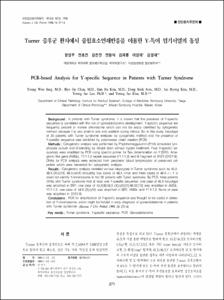KUMEL Repository
1. Journal Papers (연구논문)
1. School of Medicine (의과대학)
Dept. of Laboratory Medicine (진단검사의학)
Turner 증후군 환자에서 중합효소연쇄반응을 이용한 Y-특이 염기서열의 동정
- Alternative Author(s)
- Chun, Hyo Jin; Jeon, Dong Seok; Kim, Jae Ryong
- Journal Title
- 대한임상병리학회지
- ISSN
- 1015-6445
- Issued Date
- 1998
- Keyword
- Turner syndrome; Y-specific sequence; PCR; Gonadoblastoma
- Abstract
- Background : In patients with Turner syndrome, it is known that the presence of Y-specific
sequence is correlated with the risk of gonadoblastoma development. Y-specific sequence are
frequently present in marker chromsome which can not be easily identified by cytogenetic
method, because it is very small in size and unstable during mitosis. So, in this study, karyotype
of 30 patients with Turner syndrome analyzed by cytogenetic method and the presence of
Y-specific sequence was identified by polymerase chain reaction (PCR).
Methods : Cytogenetic analysis was performed by Phytohemaggulutinin (PHA)-stimulated lymphocyte
culture and G-banding by Wright stain without trypsin treatment. Four Y-specific sequences
were amplified by PCR using specific primer for Sex determination on Y (SRY), Ameglonin
like gene (AMGL), Y1.1-1.2 repeat sequence (Y1.1-1.2) and B fragment of DYZ1 (DYZ1-B).
DNAs for PCR analysis were extracted from peripheral blood lymphocytes of preserved cell
pellets which were harvested for cytogenetic analysis.
Results : Cytogenetic analysis revealed various karyotypes in Turner syndrome such as 45,X,
46,X,i(X)(q10), 46,X,del(X) including four cases of 46,X,+mar and three cases of 46,X,+r. It is
could not identify Y-chromosome in this 30 patients with Turner syndrome. By PCR, three patients
(10%) with Turner syndrome had at least one Y-specific sequence; one case of 45,X karyotype
was amplified in SRY; one case of 45,X[9]/46,X,i(X)(q10)[1]/46,XX[10] was amplified in AMGL,
Y1.1-1.2; one case of 46,X,i(X)(q10) was amplified in SRY, AMGL and Y1.1-1.2. None of case
was amplified in DYZ1-B.
Conclusions : PCR for amplification of Y-specific sequence was thought to be useful in detection
of Y-chromosome, which might be helpful in early diagnosis of gonadoblastoma in patients
with Turner syndrome.
배경 : Turner 증후군환자가 Y-특이 염기서열을 보유하고 있으면 흔적 성선에서 성선모세포종이 발생할 가능성이 있다고 알려져
있다. Y-특이 염기서열은 염색체검사상 그 유래를 밝힐 수 없는
표식 염색체에 존재하는 경우가 많고, 이 염색체는 흔히 세포분열
과정에서 소실되어 염색체검사로는 그 존재를 증명할 수 없는 경우
가 있다. 이에 이 연구에서는 염색체검사로 Turner 증후군 환자의
핵형을 분석하고 중합효소연쇄반응을 이용하여 Y-특이 염기서열
을 동정하고자 하였다.
방법 : 대상은 1992년 1월부터 1997년 2월까지 계명의대 동산의
료원 임상병리과에 유전성질환을 의심하여 염색체 검사가 의뢰된
2,900 명중 Turner 증후군으로 확진된 30 명의 환자로 하였다. 염
색체검사에서는 환자의 말초혈액의 림프구를 phytohaemagglutinin으로
자극한 후 72 시간 배양하여, trypsin 처리 없이 Wright
염색액으로 G-분염을 시행하였다. Y-특이 염기서열의 동정은 Y-
염색체 단완의 SRY와 AMGL과 Y-염색체 장완의 Y1.1-1.2과
DYZ1-B 등의 4 가지 표지자에 대해 중합효소연쇄반응법으로 실
시하였고, 검체는 말초혈액 혹은 염색체검사 후 보관하였던 세포침
사를 사용하였다.
결과 : 염색체검사에서 Turner 증후군 환자의 핵형은 전형적인
45,X 이외에 46,X,i(X)(q10), 46,X,+r, 46,X,+mar, 46,X,del(X)
같이 구조적 이상을 동반한 경우와 모자이크형 등으로 다양하였으
며 Y-염색체의 존재가 확인된 예는 없었다. 중합효소연쇄반응로
Y-특이 염기서열이 동정된 환자는 모두 3 예(10%)로 1 예는 45,X
의 핵형으로 SRY에만 증폭이 되었고, 1 예는 46,X.i(X)(q10)의
핵형을 가지고 SRY, AMGL과 Y1.1-1.2에 증폭이 되었다. 1 예는
45,X[9]/46,X,i(X)(q10)[1]/46,XX [10]의 핵형으로 AMGL과
Y1.1-1.2에 증폭 되었으며 복부 초음파 검사상 고환이 발견되어 성
선제거술을 시행하였다. DYZ1-B에 증폭된 예는 없었다.
결론 : 이상의 결과로서 중합효소연쇄반응검사는 Y-특이 염기
서열을 동정하는데 유용하고 간단한 방법으로 생각되며, Turner
증후군 환자에서 Y-염색체 유래의 유전물질이 존재하면 속발할 가
능성이 있는 성선모세포종 발생 위험을 예측하는데 도움을 줄수 있
을 것으로 생각된다.
- Alternative Title
- PCR-based Analysis for Y-specific Sequence in Patients with Turner Syndrome
- Department
- Dept. of Laboratory Medicine (진단검사의학)
- Publisher
- School of Medicine
- Citation
- 장영우 et al. (1998). Turner 증후군 환자에서 중합효소연쇄반응을 이용한 Y-특이 염기서열의 동정. 대한임상병리학회지, 18(2), 271–278.
- Type
- Article
- ISSN
- 1015-6445
- Appears in Collections:
- 1. School of Medicine (의과대학) > Dept. of Laboratory Medicine (진단검사의학)
- 파일 목록
-
-
Download
 oak-bbb-3403.pdf
기타 데이터 / 715.18 kB / Adobe PDF
oak-bbb-3403.pdf
기타 데이터 / 715.18 kB / Adobe PDF
-
Items in Repository are protected by copyright, with all rights reserved, unless otherwise indicated.